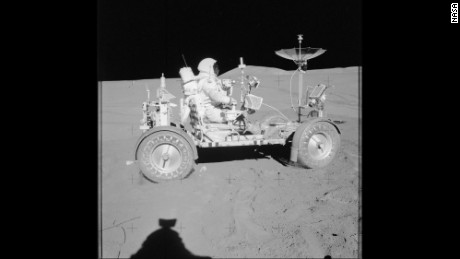Moon's interior may contain water, Brown University scientists say

Astronaut David Scott in a Lunar Roving Vehicle during the Apollo 15 lunar mission in 1971. Samples brought back from a 1971 mission helped scientists determine there was water on the moon.
Astronaut David Scott in a Lunar Roving Vehicle during the Apollo 15 lunar mission in 1971. Samples brought back from a 1971 mission helped scientists determine there was water on the moon.
Story highlights
Scientists found evidence of water trapped in "glass beads" on the surface of the moon
Water could potentially be extracted from the volcanic deposits
(CNN)There may be water -- a good bit of it -- deep inside the moon, scientists at Brown University say.
By analyzing satellite images, the scientists found evidence of water trapped in "glass beads" in ancient ash and rocks that volcanoes spewed across the surface of the moon, said Ralph Milliken, lead author of the new research, published in Nature Geoscience, and an associate professor in Brown's Department of Earth, Environmental and Planetary Sciences.
"The fact that nearly all of them (the volcanic deposits) exhibit signatures of water suggests ... that the bulk interior of the moon is wet," he said in a news release.
r may contain water, Brown University scientists say
By Ralph Ellis, CNN
Updated 11:07 AM ET, Mon July 24, 2017
Astronaut David Scott in a Lunar Roving Vehicle during the Apollo 15 lunar mission in 1971. Samples brought back from a 1971 mission helped scientists determine there was water on the moon.
Astronaut David Scott in a Lunar Roving Vehicle during the Apollo 15 lunar mission in 1971. Samples brought back from a 1971 mission helped scientists determine there was water on the moon.
Story highlights
Scientists found evidence of water trapped in "glass beads" on the surface of the moon
Water could potentially be extracted from the volcanic deposits
(CNN)There may be water -- a good bit of it -- deep inside the moon, scientists at Brown University say.
By analyzing satellite images, the scientists found evidence of water trapped in "glass beads" in ancient ash and rocks that volcanoes spewed across the surface of the moon, said Ralph Milliken, lead author of the new research, published in Nature Geoscience, and an associate professor in Brown's Department of Earth, Environmental and Planetary Sciences.
"The fact that nearly all of them (the volcanic deposits) exhibit signatures of water suggests ... that the bulk interior of the moon is wet," he said in a news release.
This finding might be a boon for future missions to the moon because water could potentially be extracted from the volcanic deposits, Milliken told CNN.
Though the volcanic glass beads don't contain much water -- maybe a few hundred parts per million -- there's a great deal of the volcanic material to work with, Millliken told CNN. Some fields of this volcanic refuse cover thousands of square kilometers and may be several kilometers deep, he said.
"It's more water than previously recognized," he said.
Volcanic glass beads
Previous findings of water on the moon didn't appear to come from indigenous sources, Milliken said.
In 2009, NASA announced it had found water on the moon. One ton of the moon's surface might yield 32 ounces, NASA scientists said.
Scientists speculated those crystals might have been created by solar winds that interacted with hydrogen at high altitudes, Milliken said. There are also small amounts of frozen water at the moon's poles, he said.
Scientists believed the moon was dry when the Apollo missions started in the 1960s. That thinking changed in 2008 when volcanic glass beads brought back by the Apollo 15 and 17 missions of 1971 and 1972 were found to contain tiny crystalline formations that contained water, the Brown news release said.
But nobody knew if those Apollo samples represented the whole moon or just unusual spots on an otherwise dry surface, Milliken said.
Scientists at Brown took another look at images of the moon's surface retrieved from the Moon Mineralogy Mapper, an imaging spectrometer that flew aboard India's Chandrayaan-1 lunar orbiter in 2008.
These images showed materials never examined by the Apollo missioins. After developing a "thermal correction" that separated the readings of reflected light and heat, scientists were able to collect data showing evidence of the glass beads in nearly all the volcanic deposits spread across the moon, Brown said.
"The distribution of these water-rich deposits is the key thing," Milliken said in the news release. "They're spread across the surface, which tells us that the water found in the Apollo samples isn't a one-off."
Is it worth the cost?
Man has not set foot on the moon since the Apollo 17 mission in December 1972. Milliken said the moon could serve mankind, even if we don't want to stay there for very long.
"If we want to send people to Mars, you might consider using the moon as a stepping stone for training or testing equipment," he said. "If you do that you'll need water. It's heavy and expensive to lift off earth."
But can the water actually be extracted and would it be worth the cost? That's one of the big questions about the discovery, he said.
And how did the water get on the moon in the first place?
Scientists think the moon was created by debris left behind when a planet-sized object slammed into the Earth, Milliken said.
"The growing evidence for water inside the moon suggest that water did somehow survive, or that it was brought in shortly after the impact by asteroids or comets before the moon had completely solidified," Shuai Li, a co-author of the research and a postdoctoral researcher at the University of Hawaii, said in the news release. "The exact origin of water in the lunar interior is still a big question."
http://www.cnn.com/2017/07/24/us/moon-water-study/index.html